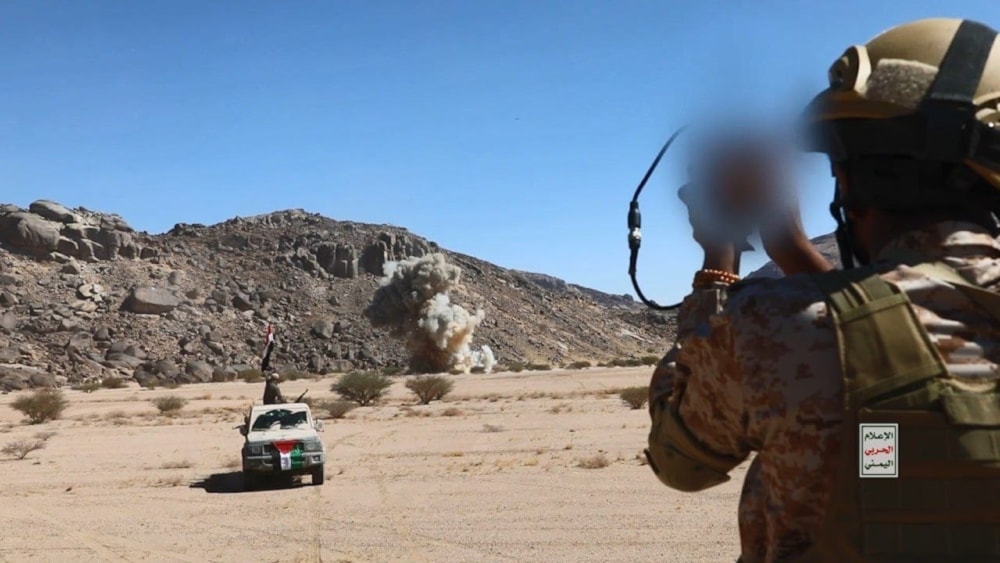Much of Yemeni offensive capability is intact after US-led strike: NYT
US officials acknowledge that locating the Yemeni forces' targets has become more difficult than expected.
-

Scenes from the Promised Conquest and Holy Jihad exercises (Yemeni Military Media)
About three-quarters of the Yemeni forces' ability to launch missiles and drones at ships in the Red Sea remained intact, despite the US-led strikes on several locations in Yemen on Thursday and Friday, The New York Times (NYT) reported on Saturday citing two US officials.
The newspaper recalled what Lt. Gen. Douglas Sims, the director of the US military’s Joint Staff, said on Friday that the strikes had achieved their objective of damaging the Yemeni forces' ability to launch an attack similar to the one they had carried on Tuesday against an American ship providing support for the Israeli occupation.
However, the two US officials revealed that even after 60 strikes with more than 150 precision-guided munitions, only about 20-30% of the Yemeni forces' offensive capability - most of which is installed on mobile platforms that can be easily transported or concealed - has been reportedly damaged or destroyed, much of which is mounted on mobile platforms and can be readily moved or hidden.
The officials acknowledged that locating Yemeni forces' targets has become more difficult than expected. According to the officials, American and other Western intelligence agencies have not dedicated substantial time or resources in recent years to gather information about the whereabouts of the Yemeni forces' air defenses, command centers, munitions depots, as well as storage and production facilities for drones and missiles.
In the same context, a British official told The Times newspaper that Yemeni leaders have long known how to hide the most valuable military assets from Saudi Arabia, which has been bombing Yemen with airstrikes for years.
The Guardian also warned that by carrying out strikes against Yemen, US President Joe Biden and UK Prime Minister Rishi Sunak "have started something they may find difficult to finish."
According to the news website, the basic problem "of which the US and British governments are doubtless aware, is that the military action taken so far may not prove wholly effective."
It noted that the Yemeni Ansar Allah forces "are used to being bombed", especially during the Saudi-led aggression on the country.
The Guardian indicated that this implies that the US and the UK "are getting themselves into an open-ended shooting war they cannot win – and that their action is thus essentially futile."
On its part, Bloomberg suggested that the success of the US and British strikes in Yemen is outlying, as the chances of Yemen losing all its missile strike capabilities overnight are unlikely, highlighting that much of these capabilities are mobile and difficult to target.
Earlier, The New York Times cited analysts as saying the airstrikes on the Yemeni Armed Forces (YAF) will do little to deter them from the Red Sea.
Farea al-Muslimi, a Yemen specialist at Chatham House, stated that the strikes were mostly symbolic in nature, adding that the sites are "really only peanuts" in the military capabilities of Ansar Allah, particularly their maritime weapons.
"They are savvier, more prepared, and more equipped than anyone is really acknowledging."
Meanwhile, The Times reported that the threats from Ansar Allah after the strikes against them took place only indicate that they are completely "undeterred from attacking ships in the Red Sea."
One former senior defense figure stated that he did not believe the group would take warnings seriously, and they would "even step up the attacks on the shipping."
On Saturday, the 141st Infantry Brigade of the Yemeni Armed Forces conducted the "Promised Conquest and Holy Jihad" exercises in the sixth military district of Yemen, including the northern provinces of Saada, Amran, and al-Jawf, a few hours after US forces renewed their aggression on several locations in Yemen.
مناورة "معركة الفتح الموعود والجهاد المقدس" محور البقع المنطقة العسكرية السادسة - فلاشة pic.twitter.com/2f2NlEBJG4
— الإعلام الحربي اليمني (@MMY1444) January 13, 2024
The drills are considered a strategically significant exercise and have highlighted a coordinated effort that involved the unmanned Air Force, anti-tank units, snipers, engineering teams, artillery divisions, armored forces, infantry units, military communications, and the Specific Tasks Unit.
Read more: Ships in Red Sea distinguishing themselves from Israeli vessels

 4 Min Read
4 Min Read










